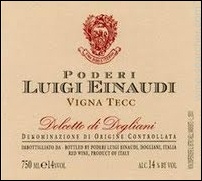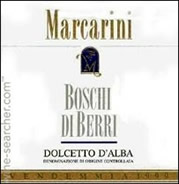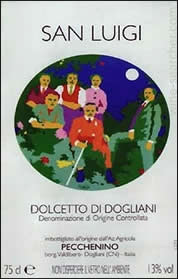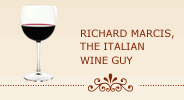Dolcetto Wines - Hiding in Plain Sight
Dolcetto is the name of a grape as well as the name of the wine made from that grape. It is grown primarily in northwestern Italy in the Piedmont region. While Dolcetto also grows in other regions of northern Italy - as well as Australia and California - Dolcetto does not travel particularly well and Dolcetto from the Piedmont is generally regarded as the best Dolcetto. This despite the fact that in the Piedmont region, Dolcetto has to compete for prime growing space and attention from producers that also grow more "prestigious" varieties such as Nebbiolo and Barbera.
Dolcetto is an early-ripening grape and like many similar varieties produces wines that are soft, fruity and acidic with mild tannins. As such, they generally do not benefit from long bottle ageing. Dolcettos are very popular in Italy, particularly in the Piedmont region, and many Italians use it as their everyday, go-to wine. It is a fixture at daily dinner tables and for entertaining close friends while they hold their more celebrated Barolo, Barbaresco and Barbera wines - which are grown in the same areas and by some of the same producers - in reserve for special occasions. Dolcettos are relatively inexpensive, food-friendly and reliable wines that are, like the people that produce them, plain-spoken and unassuming.
Dolcetto is also relatively inexpensive - generally retailing from $15 to $25 a bottle - and its ripe fruit flavors and pleasant acidity mean that it is very flexible and adaptable to many types of food. A Dolcetto will generally go well with simple pasta or seafood dishes but will also complement more robust dishes such as tomato-based pasta and some meat dishes. With soft tannins, clean acidity and fruit-forward flavors, Dolcettos are food-friendly, easy to drink and engaging.
There are seven defined Dolcetto districts in the Piedmont. Of these, three merit the most attention. One is the Dolcetto d’Alba district which is of interest because it produces a lot of generally reiiable Dolcetto and is readily available in U.S. markets. Dolcetto d’Alba wines are generally modestly priced with enticing red fruit flavors and pleasant tannins.
The other two districts of note are Dolcetto di Diano d’Alba and Dolcetto di Dogliani. These districts are generally recognized as the source of some of the Piedmont’s best Dolcetto. While there are some minute differences between the Dolcettos produced in these two regions, in general the wines are more full-bodied, structured and age-worthy than are Dolcettos from other districts. Dolcetto wines from Dogliani that meet certain ageing, crop yield and other requirements can qualify for a DOCG designation.
Although Dolcetto di Dogliani or Dolcetto di Diano d’Alba are a little more expensive and harder to find on wine shop shelves than Dolcetto d’Alba wines, they are always worth looking for.
The popular perception of Dolcetto as good and reliable but not especially interesting is changing as producers in Diano d’Alba and Dogliani - and elsewhere in the Piedmont - are fashioning and marketing Dolcettos of character and distinction. This may involve such simple things as planting Dolcetto grapes in better vineyard locations as well as better vineyard management procedures such as more extensive pruning and/or just better management of the plants. It may also involve more innovative cellar management practices such as ageing Dolcettos in new oak barrels as opposed to more traditional stainless steel tanks. Dolcetto wines typically don’t have much of a tannic structure but wood ageing adds greater structure and tannic backbone. Not surprisingly, initiatives to fashion a more “modern” Dolcetto are typically accompanied by higher prices.
Listed below is my short list of favorite Dolcetto producers (in no particular order). For those new to Dolcetto, a taste of any of these quality-driven, utterly delicious Dolcetto wines will leave you wondering, “Where have they been hiding? How did I miss them?”
Poderi Luigi Einaudi
Poderi Luigi Einaudi was founded in 1897 by university professor Luigi Einaudi who eventually went on to become Italy's first President in 1948 and served with distinction in that capacity. Despite the time-consuming commitments of his office, Luigi always found time to tend to his vineyards near Dogliani. The Poderi Einaudi grew by acquiring numerous vineyards and today has approximately 360 acres in some of the most prized properties in Dogliani and Barolo. It has a fine line-up of red and wine wines including three Dolcettos from its Dogliani vineyards that are among the best produced. This includes the entry-level “regular” Dolcetto di Dogliani, produced from a blend of Dolcetto grapes from over the estate, and two single-vineyard Dolcettos, the rich and concentrated “Vigna Tecc” and the age-worthy “I Filari”. In 2010 Einaudi decided to discontinue the I Filari line and concentrate on Vigna Tecc as its sole cru Dolcetto.
Luigi Einaudi, Dolcetto di Dogliani DOC 2009 (about $22)
This is the estate’s entry-level Dolcetto and is produced from a blend of Dolcetto grapes from the estate’s vineyards around the small town of Dogliani. The wine spends eight months maturing in steel tanks and two months in in the bottle prior to release in the summer following the harvest. It is a traditional, easy to drink wine with a rich and fruity bouquet, medium-body and a pleasantly tannic taste with the traditional, slightly bitter note of almond on the finish.
Luigi Einaudi, “Vigna Tecc” Dogliani Superiore DOCG 2010 (about $23)
The Vigna Tecc Dolcetto is from grapes harvested from the estate’s  Tecc vineyard south of Dogliani, one of the estate’s oldest vineyards. This wine carries a Dogliani Superiore DOCG designation which imposes even more stringent requirements than the regular Dogliani DOCG designation. The wine spends a year maturing in a combination of steel tanks and wood casks and two months in the bottle prior to release for sale. The wine is full-bodied, rich and concentrated with dark fruit flavors followed by Dolcetto’s signature notes of bitter almonds on the finish. The 2010 Vigna Tecc is a recipient of a prestigious Tre Bicchieri award from Gambero Rosso.
Tecc vineyard south of Dogliani, one of the estate’s oldest vineyards. This wine carries a Dogliani Superiore DOCG designation which imposes even more stringent requirements than the regular Dogliani DOCG designation. The wine spends a year maturing in a combination of steel tanks and wood casks and two months in the bottle prior to release for sale. The wine is full-bodied, rich and concentrated with dark fruit flavors followed by Dolcetto’s signature notes of bitter almonds on the finish. The 2010 Vigna Tecc is a recipient of a prestigious Tre Bicchieri award from Gambero Rosso.
Luigi Einaudi, “I Filari” Dolcetto di Dogliani DOCG 2008 (about $38)
The I Filari is produced from hand-selected grapes from the best rows of the Einaudi vineyards in Dogliani. The wine matures in a combination of medium and small oak barrels and spends a few months ageing in the bottle prior to release for sale. It a quality wine which, unlike most Dolcetto wines, ages extremely well and in fact needs to spend a few years in the cellar to enjoy at its best. This formidable Dolcetto has a rich vinous fragrance, is full-bodied with a velvety, dense texture and gritty tannins enhanced with subtle kitchen spice notes. As mentioned above, Einaudi is no longer producing the I Filari Dolcetto so it will be increasingly difficult to find over time. If you find one, buy it.
Marcarini
Established in the 1850’s in the commune of La Morra, the Marcarini estate has established a well-earned reputation for turning out top quality Barolo, Barbera and Dolcetto wines. All their wines are distributed worldwide into a growing international market. The estate produces two Dolcetto wines, Fontanazza and Boschi di Berri.
Marcarini, Dolcetto d’Alba “Fontanazza” 2009 (about $18)
The Fontanazza is produced from grapes grown on 25 year-old vines. It is made in the “traditional” manner i.e., the wine is aged in steel tanks and doesn’t see any oak ageing. It’s warm and inviting with a full and velvety texture. The wine has enticing fruity aromas, a pleasant acidity and a delicate, slightly bitter aftertaste.
Marc arini, Dolcetto d’Alba “Boschi di Berri” 2007 (about $28)
arini, Dolcetto d’Alba “Boschi di Berri” 2007 (about $28)
This is a truly unique Dolcetto d’Alba. The grapes come from century-and-a-half-old native vines that were saved from the phylloxera disease thanks to the vineyard’s particular microclimate and its sandy soil that insulated the plants rootstocks from disease. The wine is aged in stainless steel tanks for a short period and then spends an additional five months in large oak barrels. It is a unique and aristocratic wine with an intense and persistent bouquet, rich flavor and full body. Boschi di Berri typically needs several years ageing in the cellar to enjoy at its best.
Azienda Agricola Pecchenino
Founded in the late 1800’s, this family estate is currently run by two brothers, Orlando and Attilio Pecchenino, the 4th generation to run the winery. Currently, the Pecchenino winery owns approximately 72 acres, most of which are located in the Commune of Dogliani with a small parcel in Monforte d'Alba. They manage their winery in a sustainable fashion and follow organic farming principles that utilize organic compost and eschew the use of any chemical products for weed or pest control.
The Pecchenino winery has played an outsized role in the movement to upgrade Dolcetto’s image by fashioning wines of character and distinction. While the Pecchenino estate grows Barbera, Nebbiolo and some Arneis grapes in addition to Dolcetto, their primary focus is on Dolcetto and over three-quarters of their land under vine is given over to Dolcetto.
They produce several versions of Dolcetto from different vineyards that include San Luigi, Siri d’Jermu and Bricco Botti.
Pecchenino, “San Luigi” Dolcetto di Dogliani 2011 (about $18)
The San Luigi is Pecchenino’s entry-level Dolcetto wine. It is aged in stainless steel until the spring of the following year. This is a straightforward, medium-bodied Dolcetto with appealing fruit flavors and good acidity.
Pecchenino, “Siri D’Jermu” Dogliani Superiore 2009 (about $25)
The Siri D’Jermu spends a year ageing in oak casks. It is intense and concentrated with a pleasant tannic backbone. The wine is rich, intense and concentrated with good acidity and ample tannins that hold everything nicely in balance. While most Dolcettos are meant to be consumed within a year or two, this one has plenty of staying power.
Pecchenino, “Bricco Botti” Dogliani Superiore 2008 (about $29)
This is a single-vineyard expression of Dolcetto. The grapes for this Dolcetto get a long maceration on the skins and the wine then spends 2 years ageing in large oak casks. This extra year in wood makes all the difference. The wine is aromatic, rich and complex with opulent, dark fruit flavors, lively acidity and velvety tannins. Production of this wine is limited and hard to find in the U.S. but well worth the effort.
Other Quality Dolcetto Wines
There are a lot of Dolcettos on the market. Other fine Dolcetto wines that didn’t quite make the short list but are sure to please include the following (in alphabetical order by producer):
Marziano Abbona, Dogliani DOCG “Papa Celso” 2009 (about $28)
This is an impressively structured and generous Dolcetto that is sure to please any discerning Dolcetto enthusiast.
Giacomo Ascheri, Dolcetto d’Alba “Vigna San Rocco” 2010 (about $22)
Vigna San Rocco is a classy Dolcetto with loads of varietal character. This is a great introduction to Dolcetto and an excellent value at this price.
Cantina del Pino, Dolcetto d’Alba 2010 (about $18)
From a small, family managed winery in the Barbaresco zone, this enjoyable, food-friendly Dolcetto is sure to please your taste buds as well as your wallet.
Pio Cesare, Dolcetto d’Alba 2011 (about $21)
This historic, family-owned estate has been producing traditional Piemontese wines since the late 1800’s. This distinctive Dolcetto comes primarily from grapes harvested in selected estate vineyards in the Barolo and Treiso areas. It is fruity and fragrant with good body, structure and spicy fruit flavors.
Manzone, “Le Ciliegie” Dolcetto d’Alba 2009 (about $15)
Manzone’s 2009 “Le Ciliegie” (pronounced lay chi' leh zhee; Italian for "the cherries") is made from grapes harvested in the winery’s Le Ciliegie vineyard in Monforte d’ Alba. Intense and winey with juicy, red fruit flavors, this is a maximum Dolcetto at a minimum price.
Marchesi di Gresy, Dolcetto d’Alba “Monte Aribaldo” 2009 (about $21)
The grapes for this wine are harvested from the Marchesi di Gresy’s Monte Aribaldo estate in the commune of Treiso. Velvety and fruity with gentle tannins and Dolcetto’s benchmark bitter almond finish.
Massolino, Dolcetto d’Alba 2011 (about $20)
Massolino’s Dolcetto d’Alba uses the best Dolcetto grapes from their several vineyards in Serralunga d’Alba. This is a classy wine with dark fruit flavors and light spice notes.
Moccagatta, Dolcetto d’Alba 2010 (about $15)
This wine spends four months ageing in medium-size oak casks for greater structure and complexity. There are no hard edges to this wine, just a velvety texture and intense fruit flavors. It is a great value at this price.
Pasquero-Elio, Dolcetto d’Alba “Sori Paitin” 2010 (about $19)
The “Sori-Paitin” Dolcetto d’Alba is aged in a combination of stainless steel tanks and large oak casks. The result is a very elegant and classy Dolcetto.
Renato Ratti, Dolcetto d’Alba “Colombe” 2010 (about $19)
This is a serious Dolcetto with intense plum aromas, good acidity and dark fruit flavors.
Luciano Sandrone, Dolcetto d’Alba 2010 (about $22)
This Dolcetto comes from grapes gathered from a number of Sandrone’s vineyards. Each lot is vinified separately in steel tanks and then blended and bottled. This is an elegant Dolcetto made by a discerning producer.
Gianni Voerzio, Dolcetto d’Alba “Rochettevino” 2009 (about $25)
A polished, food-friendly Dolcetto with earthy fruit tones, lively acidity and a long fruity finish.
©Richard Marcis
January 24, 2013
Return to italian wine reviews


